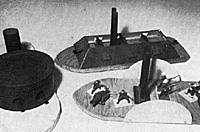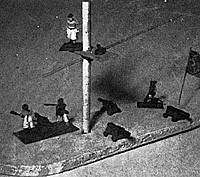 Materials: 1/2" plywood for hull; 1/4" dowel
for mast; 3/32" dowel for spar (throat swab, 6" long);
Popsicle stick for fighting top; Elmer's glue.
Materials: 1/2" plywood for hull; 1/4" dowel
for mast; 3/32" dowel for spar (throat swab, 6" long);
Popsicle stick for fighting top; Elmer's glue.
The "Basic Ship" described in this article is a design that is extremely simple and versatile. When set up as a sailing ship it represents a small cutter, rather than one of its larger sisters. It has been my experience that this type of ship is more useful on the gaming table as it lends itself to combined land and sea operations as well as to pure ship-to-ship actions.
The rather simple design was arrived at after years of struggling with larger, cluttered versions. I have found that a single mast with a spar allows all the rigging/mast damage that is needed to be adequately represented without creating a tangle of jutting sticks that get in the way of sailors, guns and life-size hands attempting to manipulate same.
Furthermore, the completed model looks right and keeps the emphasis on the miniature figures. The photo shows a staggered placement of the cannon on the deck which was very common to these small ships. When more guns were wanted on one side the guns from the other side were shifted over to bring maximum firepower to bear. In a close action a foxy captain might catch his opponent on his unarmed side with some clever maneuvering.
 Variations on the basic design can be made by
building small platforms to represent the after castles and
forecastles of early sailing ships (which tend to run on the
small side for the most part) or by cutting posterboard
"sidewheels" for colonial gunboats.
Variations on the basic design can be made by
building small platforms to represent the after castles and
forecastles of early sailing ships (which tend to run on the
small side for the most part) or by cutting posterboard
"sidewheels" for colonial gunboats.
A most satisfactory Monitor can be made by cutting down a "Pringle's Potato Chip" can and clapping the lid back on. Cut two small gunports on one side and paint the whole thing black. You don't even need guns for this one unless you are a purist. A Merimac type is a little tougher as the sides should slope to create the desired effect. Don't use very much slope if you try this one as it makes it very hard to get the figures inside if the slope is too severe.
CONSTRUCTION
Saw a plywood rectangle 3" x 8". Draw a centerline down the length to help in locating the point of the bow and the hole for the mast. The curve of the bow should end at a point 1 1/2" from the end. Sketch in a nice rounded arc to make a rather"bluff" bowed appearance. This makes a nicer look and gives you more room for the cannon and figures.
The mast is located (stepped, in nautical terms) 3 1/2" from the bow. Drill a 1/4" hole all the way thru the hull, being careful to drill straight down or your mast will have a bit of a cant to it. When you put the mast in it may be a bit tight so you may have to ream the hole out a bit. Don't overdo this, better a little tight than too loose. The mast is 1/4" dowel, 4 1/2" tall. The fighting platform is 1 1/2" from the top and is made of two pieces of popsicle stick 2" long with a square opening in the center for the mast to pass thru. Cut half the opening in each plank before gluing together.
The underside of the platform can be reinforced with a couple pieces of wood to help hold the planks in position and can also be fastened to the sides of the mast to keep the platform from tipping. The spar is a 3/32" dowel, 6" long with a small bit of wood glued on it at a point 1 3/4" from one end to act as a stop to keep the spar from sliding uncontrollably thru the hole in the mast The mast should be drilled at about a 15 degree angle.
The basic model is now ready for a coat of paint. If you I are handy, you can make up a small swivel for the fighting top and if you want to complete the arsenal, add a small coehorn mortar to lob grenades onto the enemy's deck (Minifigs "Signal Mortar" in the MFA artillery range is perfect). In a pinch, a marksman can be placed in the top with the gunner, but you had better tie him to the mast or he might be damaged in a fall should the ship roll unexpectedly. Sailors and cannon in the photos are from Minifigs "Iron Men for Wooden Ships" range of 25mm figures for the 18th Century version. The other photos are an assortment of old Minifigs Renaissance, Ral Partha and Airfix. The "Coke Bottle" cannon were taken from an old model of the Civil War Sloop, "Kearsarge".
When determining casualties in these small shipboard actions, try to keep the damage from each hit on the light side. One man per cannon hit is enough. One rigging hit can take out the spar while a second can cause the mast to come down. Eight hull hits seems to be about right and a crew of about 16 to 20 is the limit. It is a simple matter to scale down for 15mm figures.
Back to Table of Contents -- Courier Vol. 2 #6
To Courier List of Issues
To MagWeb Master Magazine List
© Copyright 1981 by The Courier Publishing Company.
This article appears in MagWeb (Magazine Web) on the Internet World Wide Web.
Other military history articles and gaming articles are available at http://www.magweb.com